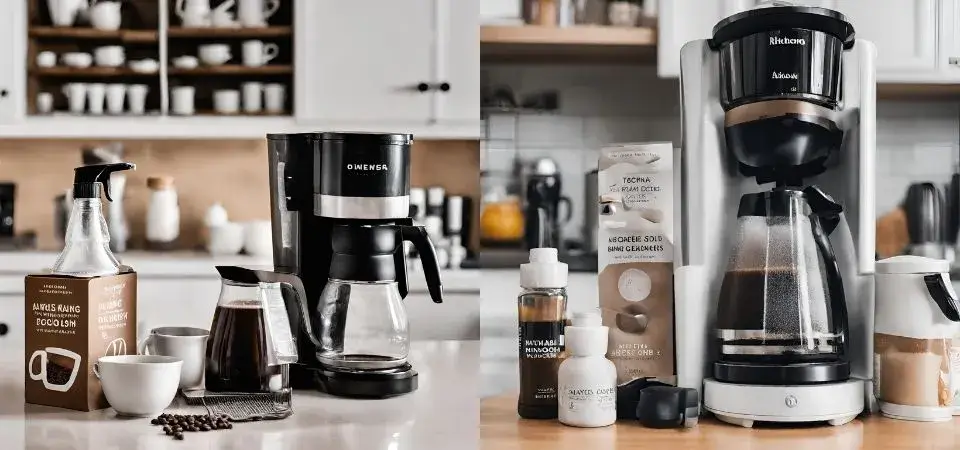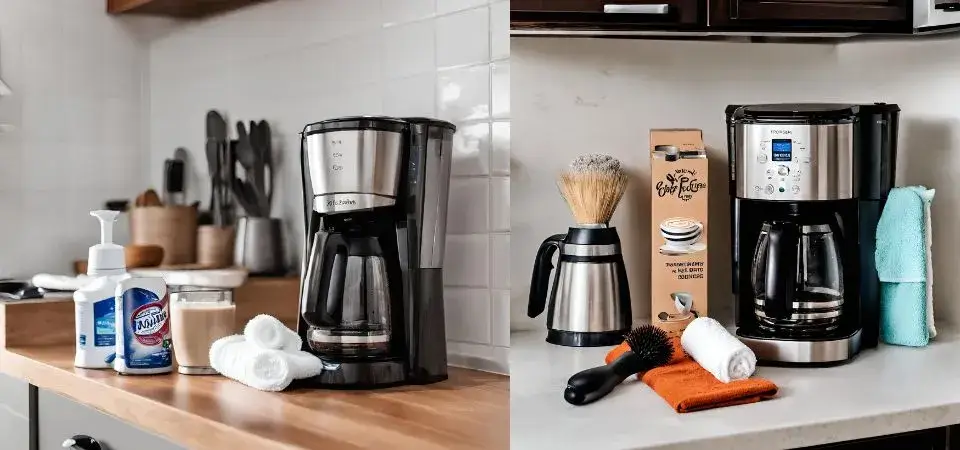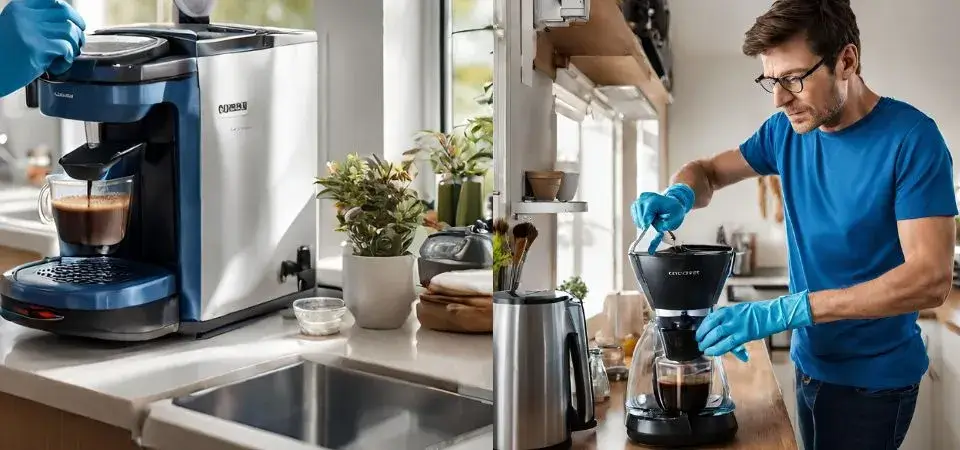More than 1.12 billion people like to drink coffee. But coffee drinkers don’t know how to clean a coffee maker without vinegar. Here are some steps you can clean your coffee maker using a blend of water and baking soda or lemon juice. We will guide you through a hassle-free cleaning process that leaves your machine look like new and your coffee flavors unstained.
The Problems with Using Vinegar to Clean Coffee Makers

Vinegar may seem like a safe cleaning solution, but using it in your coffee machine can cause several issues.
Damages Parts
- Acetic acid corrodes metal components like the heating element.
- It wears down plastic tubing, causing cracks and leaks.
Alters Taste
- Leaves behind an acidic residue that makes coffee taste sour.
- Absorbs into plastic pieces, tainting the flavor of future brews.
Causes Harmful Buildup
- Reacts with mineral deposits to form a sludgy limescale.
- This buildup clogs the machine and is difficult to remove.
While vinegar has some benefits for cleaning, the risks outweigh them for coffee machine maintenance. The acidity can change the flavors of your coffee and damage the appliance itself.
Safe and Alternative clean Ideas for the coffee maker
Cleaning your coffee maker is important. Old coffee oils and grounds make coffee taste bad. Natural cleaners like vinegar, lemon, and baking soda clean well without chemicals. They break down gunk and kill germs. Regular cleaning cycles with water keep your coffee maker working right. Clean coffee maker equals tastier, healthier coffee. Simple, safe cleaning improves flavor and reduces waste.
1. Lemon Juice: A Natural Descaling Option
Lemon juice is a natural acid that breaks down the scale effectively. It’s gentle on the machine but tough on buildup.
- Combine equal parts of lemon juice and water.
- Run the mixture through a brewing cycle.
- Follow up with a rinse cycle using only water to eliminate any lemon taste.
2. Using Baking Soda To Deodorize And Cleanse
Baking soda, a common kitchen staple, offers excellent cleaning properties. It’s a mild, natural abrasive that helps scrub away stains and residues.
- Mix a quarter cup of baking soda with water.
- Fill the coffee maker’s water chamber with this solution.
- Run a full brew cycle.
- Rinse by brewing fresh water at least once.
3. Hydrogen Peroxide For Disinfecting And Stain Removal
Hydrogen peroxide disinfects and whitens surfaces effectively. It tackles tough coffee stains with ease.
| Step | Instruction |
|---|---|
| 1 | Combine two parts of water with one part of hydrogen peroxide. |
| 2 | Fill the water reservoir and run a brew cycle. |
| 3 | Rinse the system with clean water cycles until odourless. |
| 4 | Oxidizing formula breaks down oils and residues. |
| 5 | It won’t alter the coffee’s taste. |
| Rinse the system with clean water cycles until odorless. |
Using the right cleaner for the job will allow you to wash away impurities while keeping your machine like new shape.
Step-by-step Cleaning Process Without Vinegar
Keeping your coffee maker clean ensures every cup tastes fresh. You don’t always need vinegar for a sparkling machine. Follow these steps to clean efficiently without it.
Preparation: What You’ll Need To Clean Your Coffee Maker
Let’s gather the essentials:
- Lemon juice or baking soda – natural cleaning agents.
- Pure water – to dilute the cleaning solution.
- Soft cloth or sponge – for wiping surfaces.
- A bowl – to mix solutions.
- A dry towel – to dry the coffee maker after cleaning.
The Cleaning Cycle: Instructions For Using Alternative Solutions
Now the alternative cleaning agents:
- Mix one part lemon juice with two parts water. For baking soda, one tablespoon with a cup of water.
- Fill the reservoir with the solution.
- Run a half-brew cycle. Pause it for an hour.
- Resume the cycle. Let it complete.
- Discard the cleaning solution.
- Run two full cycles with pure water. This removes any residue.
Post-cleaning Cycle: Rinsing And Drying
Finish off with these steps:
- Empty the coffee maker.
- Wipe the machine with a damp cloth or sponge.
- Rinse any removable parts under running water.
- Let the parts air dry or use a towel.
- Reassemble once all parts are dry.
Clean regularly for the best taste in every cup.
Step-by-Step Guide to Cleaning Your Coffee Maker Without Vinegar

Now that we’ve covered why you should avoid vinegar and some alternative cleaning solutions, let’s look at the hands-on process for cleaning your coffee maker thoroughly and safely.
Deep Cleaning to Remove Mineral Buildup
About every 3-6 months, you’ll want to do a deep cleaning to remove calcium, lime scale, and other mineral deposits. This prevents clogs and buildup that can affect performance.
- Mix a descaling solution or baking soda paste according to the package directions. The acids or abrasives in these break down mineral scales.
- Run the cleaning mixture through a brewing cycle. This allows it to work on mineral deposits and rinse them away.
- Repeat as needed for stubborn buildup. Descales may require multiple cycles.
Removing Oils and Residues
For monthly maintenance, target oily residues that can lead to rancid coffee flavours.
- Brew a pot using 2 cups of water diluted with 1/4 cup hydrogen peroxide. The oxidizing properties help break down oils.
- Once done, run a full pot of plain water to rinse. Make sure no chemical taste remains.
Preventing Future Buildup
Regular cleaning prevents scale before it becomes a problem.
- Always rinse your coffee maker with plain water after use. This prevents residue from drying out and sticking.
- Use filtered water, which contains fewer minerals.
- Change water filters as recommended by the manufacturer.
- Descale as needed based on water hardness. Softer water means less frequent descaling.
Following this routine will keep your coffee maker spotless without using harsh vinegar.
Why you shouldn’t clean a coffee maker with vinegar?
There are a few good reasons to clean your coffee maker without using vinegar. First, avoiding lingering unpleasant odors is a key consideration. A strong vinegar smell may not be the most welcoming smell, especially when preparing coffee for guests. Choosing alternative cleaning methods ensures a fresh and attractive ambience. Aside from olfactory concerns, there is another aspect to consider, which is the potential damage that vinegar can do to the surface of your coffee machine. Protecting the aesthetics and longevity of your device is crucial. By choosing alternative cleaning agents, you not only avoid the risk of damage but also ensure that your coffee machine maintains its polished appearance over time.
Why is coffee machine maintenance important?
Keeping your coffee maker clean ensures every brew is delicious. Proper maintenance extends the life of your device. Yet many people overlook this simple task. Fear not, as cleaning can be easy and effective without using vinegar.
Why People Avoid Using Vinegar For Cleaning
Vinegar has a strong smell that can linger. It also might not be suitable for all coffee makers. People seek alternatives to avoid these issues. They desire a clean machine without the strong vinegar scent.
- Sensitive to the vinegar odour
- Concerns about vinegar’s effects on the machine
- Preference for other cleaning solutions
Cleaning benefits of Your Coffee Maker without Vinegar
Cleaning your coffee maker without vinegar is good. Use natural cleaners like lemon juice, baking soda, and hydrogen peroxide instead. They remove hard water gunk and bad smells inside the machine. This makes your coffee taste better. And it stops the buildup that breaks coffee makers. Cleaning properly keeps your machine working right. So use natural stuff, not vinegar, to clean your coffee maker. It makes fresh tasty coffee and a happy machine.

By skipping vinegar and using safer cleaning methods for your coffee maker, you’ll enjoy several advantages. Here are some of the key benefits:
| Improves Coffee Flavor | Your coffee maker will have better performance and last longer without corrosion damage. Fewer repairs are needed. |
| Prevents Corrosion | Non-acidic cleaners won’t corrode the coffee maker’s metal components like vinegar can over time. |
| Extends Appliance Life | Those Options like baking soda and hydrogen peroxide are natural, non-toxic cleaners. The best way for you and the environment. |
| Environmentally Friendly | Those Options like baking soda and hydrogen peroxide are natural, non-toxic cleaners. Best way for you and the environment. |
| Easy and Affordable | Most alternative cleaners are inexpensive and easy to find. Simple steps. |
| Saves Money | Avoiding costly vinegar damage and repairs down the line saves you money in the long run. A little prevention goes a long way. |
By moving away from vinegar and using cleaners specially formulated for coffee makers, you get back to brewing delicious, hot cups of coffee every morning. And you’ll extend the lifespan of your coffee machine at the same time.
Frequently Asked Questions On How To Clean A Coffee Maker Without Vinegar
Switching to vinegar-free cleaning for your coffee maker may bring up some questions. Here are answers to some often-asked FAQs:
What Is The Best Thing To Use To Clean A Coffee Maker?
The best thing to clean a coffee maker is a mixture of equal parts white vinegar and water. Run this solution through a brewing cycle, followed by a cycle with just water to rinse.
Can You Use Hydrogen Peroxide To Clean Coffee Maker?
Yes, you can use hydrogen peroxide to clean a coffee maker. Dilute it with water, run through a brewing cycle, and follow with several pure water cycles.
What Can I Use Instead Of Descale Solution?
For descaling, white vinegar or lemon juice are effective, natural alternatives to descaling solutions. Mix equal all with water and run through the appliance, then rinse thoroughly.
What Can I Use Instead Of Coffee Machine Cleaner?
You can clean your coffee machine using a mix of water and white vinegar, or with baking soda. Both solutions help remove mineral buildup and cleanse the machine effectively.
How often should I clean my coffee maker?
Do a thorough descaling every 3-6 months. Wipe away surface residues and rinse with water after each use.
What’s the best vinegar alternative for descaling my coffee maker?
Descale solutions specifically formulated for coffee makers are the most effective and safe. Look for descale powder or liquid.
What’s the best way to clean a Keurig or single-serve coffee maker without vinegar?
Use a descaling solution made for Keurig/pod coffee makers. Run multiple cycles to break down mineral deposits.
What ingredients make a good DIY coffee maker cleaner?
Baking soda, hydrogen peroxide, and water are safe for DIY solutions. Make sure to rinse thoroughly.
Conclusion
By using specialty you can clean coffee maker instead of vinegar very easily. ou can remove impurities, prevent scale buildup, and keep your coffee tasting delicious every day. With the proper maintenance and care, your coffee maker will provide years of reliable service. Never let a buildup of mineral deposits or rancid oils come between you and a perfect cup of coffee again.
Cleaning your coffee maker doesn’t require vinegar to get the job done effectively. You can use alternatives like lemon juice, baking soda, or dish soap to achieve that deep clean. Adopting these methods ensures your coffee tastes fresh and your machine remains in excellent shape. Keep your mornings blissful with a spotless coffee maker at the ready. Cheers to your next aromatic brew!





